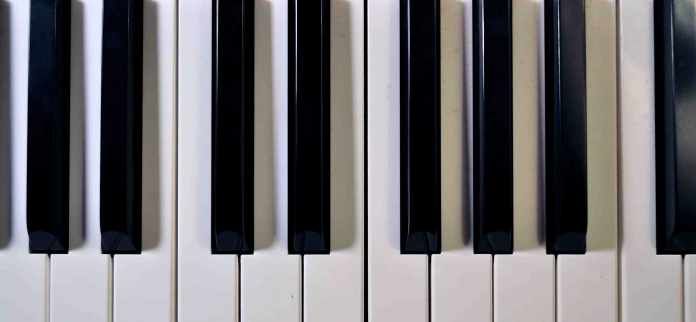EM piano chord is easy to play. However, the chord’s keynote is E. Therefore Play the E key above middle C with your 1st finger (the thumb). Then skip the following white key and again the G with 3rd finger and thus the B note with 5th finger finally. You’re now playing the EM chord in the root position and means that E, the keynote, is the lowest note of the chord. Learning to play the piano can be a daunting task in the first few hours. As with any musical instrument, practice helps you to develop a better understanding of music theory. In addition, piano playing can help improve your coordination and finger dexterity.
Table of Contents
EM piano Chord – E minor Chord on Piano
Moreover, that is a pretty easy chord to play, comprising of only white piano keys. Similarly, how is the E minor chord formed? You combine the root note, flat third, and perfect fifth of the E major scale. Notes are E, G, and B, for example, respectively. Moreover, the E minor chord is in E min and E- (the letter “E” followed by a minus sign).
Since this chord is minor, it creates a sad mood instead of a major chord that makes a happy mood. Now compare E minor and E major on the piano to hear the differences. Composers write sad songs in minor keys usually, while happy songs are in primary keys generally. But there exist exceptions to the rule, and this is quite common. To create the EM piano chord, you must combine a minor third and a Major third. The distance or interval between E and G is one and a half tones, also known as a minor third. Again the break or distance between G and B is two tones or a major third similarly.
However, in the root position, the notes are in the order E G B. You can now play this chord in two inversions. In the first Inversion, the letters in the order G B E. Then the notes are in the order of B – E- G in the 2ndInversion. Moreover, the diagram on the right illustrates this.
What is the fingering for the EM piano Chord?
For instance, here’s the right-hand fingering. However, to play the EM piano chord in the root position with your right hand, firstly place your thumb (1st finger) on E, then your middle finger (3rd finger) on G, and again your little finger (5th finger) on B. Now, play the notes together to hear your E min chord. Besides, to play EM in the 1st Inversion, place finger one on G, then finger two on B, and finger five on E. Besides playing E min in its 2nd Inversion, put your 1st finger on B firstly, then 3rd finger on E, and 5th finger on G finally.
EM piano chord happens naturally.
As you advanced in playing the piano, you will realize that the E min chord occurs naturally in specific keys. Thus, it is chord I. Similarly to EM’s relative major chord, G major is chord VI in E minor’s access. Again in the key of a child, E min is chord V. Moreover in AM’s major chord, C major, EM is chord III. On the other hand, the different key where E minor chord happens naturally is the B Minor. In of B minor key, chord IV is EM. Again in B minor’s relative major chord, D major, the EM chord is chord II.
What Is the EM piano chord?
The no minor natural scale is E -F#- G- A -B -C -D, for example. Chords in genuine Minor keys follow the pattern, minor, diminished major, and minor-major.
- Firstly E minor, Eminor seventh (E Min, Emin7)
- Then F# declined, F#little seventh flat five (F#dim, F#m7b5)
- Again G major, Gmajor seventh (Gmaj, Gmaj7)
- Next A minor, A minor seventh (Amin, Amin7)
- Again B minor, B minor seventh (Bmin, Bmin7)
- Also C major, C major seventh (Cmaj, Cmaj7)
- Finally, D major, Dominant seventh (D Maj, D 7)
E Minor Key Piano Chords
- Firstly, I – VI-VII (EM – C – D)
- Then I – IV-VII(Em–Am– D)
- Again, I – IV – v (EM– Am – BM)
- Next I – VI – III-VII(Em – C – G – D)
- Finally, II – V – I(F # m 7 b 5 – B m – E m)
Notes of All the Chords (key of E Minor)
- I – E minor: E – G – B
- IIDM – F# diminished: F# – A-C
- III – G major: G – B– D
- IV – A minor: A-C – E
- V – B minor: B – D –F#
- VI – C major: C – E –G
- VII – D major: D – F#– A
And now, the four-note chords
- I – E minor seventh: E – G – B – D
- IIDIM – F# littleseventh flat five: F# – A – C – E
- III – G MajorSeventh-G – B – D – F#
- IV – A minor seventh: A-C – E – G
- V – B minor seventh: B – D – F# – A
- VI – C major seventh: C – E – G – B
- VII – D dominant 7th:D – F # – A – C
Besides, there is one sharp in the Emin scale, namely, F#.
EM piano chord -The E Minor Scale –Natural, Harmonic, and Melodic:
However, there exist three types of minor scales-Melodic, Natural, Harmonic Minor.
E Minor Scale (Natural):
Scales consist of the pitches likewise E- F♯- G- A- B- C, and D. Its key signature consists of one sharp.
EM Scale Note Intervals:
- Tonic: E is the 1st note of the E natural minor scale.
- Major 2nd: F# is the2nd note of the plate.
- Minor 3rd: G is the3rd note of the scale.
- Perfect 4th: A is the 4th note of the scale.
- Perfect 5th: B is the5th note of the scale.
- Minor 6th: C is the6th note of the scale.
- Minor 7th: D is the7th note of the scale.
- Perfect 8th-E is the8th note.
EM piano chord Scale Degree
- Firstly-Tonic: E
- Then-Supertonic: F#
- Again-Mediant: G
- Next-Subdominant: A
- Then-Dominant: B
- Again-Submediant: C
- Next-Subtonic: D
- Again-Octave: E
However, the relative primary key of E Minor is G Major. A natural Minor scale/Key comprises of the same notes as its relative major. Letters of the G Major scale are G- A-B- C-D- E- F # as the E natural Minor utilizes these same notes, except that the sixth note of the significant scale and thus becoming root note of relative minor.
However, the formula for forming natural or pure minor scale is W-H-W-W-W-W-W. “W” stands for the whole step, and “H” stands for half action. To build an E natural minor scale, we take a fundamental step to F# starting on E. Then, take a half step to G. Again from G, a real action takes to A. Again, another whole step continues us to B. Thus from B, we go up a half step to C. From C, we take a fundamental measure to D. lastly, one fuller step returns for E.
Fingerings for the E minor scale
- Notes: E- F#- G-A-B-C-D-E
- Fingerings(Left)-5-4-3-2-1-3-2-1
- Fingerings (Right):1-2-3-1-2-3-4-5
Chords in the key of E minor:
- Chord I: E Minor- E – G – B.
- Chord II: F#diminished-F# – A – C.
- Chord III: Gmajor-Notes are G – B – D.
- Chord IV: A minor-A –C – E.
- Chord V: B minor- B –D – F#.
- Chord VI: C major-C –E – G.
- Chord VII: D Major-D– F# – A
EM piano chord Harmonic Minor Scale:
Increase the seventh natural minor scale note by a half step as you go up and down the scale. For instance: Natural E Minor Scale -E- F♯- G- A- B- C- D- E
Harmonic E Minor Scale –
E- F♯- G- A- B- C- D#- E
EM Scale Intervals (Harmonic):
- Tonic: 1st note of the E harmonic minor scale is E.
- Major 2nd: The 2ndnote of the plate is F#.
- Minor 3rd: The 3rdnote of the scale is G.
- Perfect 4th: The 4thnote of the scale is A.
- Perfect 5th is B.
- Minor 6th: On the 6th, the note is C.
- Major 7th: On the 7th, a note is D#.
- Perfect 8th: The 8th, the note is E.
Melodic Scale (Minor):
For the melodic minor scale, raise the sixth and seventh notes of a plate with a half step and then return to the natural minor as go to down the scale. The letters of the E melodic minor scale ascending are E, F♯, G, A, B, C#, D#, E. The A musical minor scale descending notes are E, F♯, G, A, B, C, D, E (E natural minor scale).
A melodic minor scale, the formula is the whole step – half step – complete step – complete step –entire stage – whole stage – half action. W-H-W-W-W-W-H -the descending formulas the natural minor scale formula backward.
Melodic EM Scale Intervals:
- Firstly -Tonic: The 1st note of the E melodic minor scale is E.
- Then-Major 2nd: The2nd note of the plate is F#.
- Again- Minor 3rd: The3rd note of the scale is G.
- Next-Perfect 4th: The4th note of the scale is A.
- Also- Perfect 5th-The 5th note is B.
- Again-Major 6th: The6th note of the scale is C#.
- Next- Major 7th: The7th note of the scale is D#.
- Finally-Perfect 8th-The 8th note is E.
EM piano chord Flat:
However, Ebm, Eb min, Eb- (Eb with a minus sign) various ways to represent this chord. Moreover, we shall use all of them here, interchangeably. Notes of the E flat Major scale, for example, are EB- F- G- AB- BB- C and D. Whereas Eb is the root or Tonic, F is the primary second, G for major third, AB for perfect fourth, BB for ideal 5th, C is the major 6th, and D for the major seventh of the major scale. In the root position, Eb with the 1st finger (Thumb), GB with the 3rd (Middle finger), and Bb with the 5th (Little finger). However, for the 1st Inversion, GB with the first finger, Bb with the 2nd (Index finger), and Eb with the 5th finger.
Wrap Up
Finally, we are known to the all EM piano chords details from the above discussion. Let’s go through and discover the new world of music.
Frequently Asked Questions (FAQs)
What is a piano chord?
A chord is created once quite one note is contending directly and contains 2, three, or a lot of individual notes. On the piano, this means you down quite one key at a similar time. All piano chords contain a root note (usually, this can be). Often, the note the chord is thought as once – additionally along or a lot of extra notes. Basic piano chords usually contain solely 2 or 3 letters, whereas many advanced chords tend to incorporate even many messages. The most common style of keyboard or piano chord could also be a triad or three-note chord. A triad contains a root note and two alternative notes, most often the notes that turnout the intervals of a third and fifth higher than the idea note.
What are piano intervals?
The distance between piano notes, referred to as associate interval determines however they sound once contend along. Intervals square measured in half-steps and whole-steps.
Half-steps.-A half-step is that the space from one key to an ulterior key. Likewise, a shot to its right or left.
Whole-steps: A whole-step is that the area of 2 half-steps.
Typical intervals-A regular break used in piano chords are that the major third is the space of 2 whole steps or four half-steps.
What are Major Piano Chords?
The most common triad three-note chord is that the major chord. Thus quality and adaptability creative piano chords for beginners to seek out 1st.








